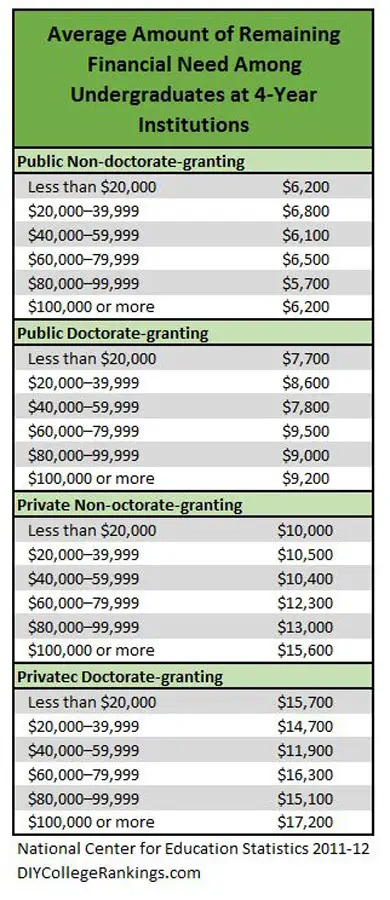 What’s the worst possible thing families could hear after getting their Estimate Family Contribution (EFC) for financial aid? How about that even if they could manage to pay their EFC, more than likely they’ll have to pay even more because most colleges won’t meet their full need. The data on who gets financial aid shows that most families aren’t going to have their need met.
What’s the worst possible thing families could hear after getting their Estimate Family Contribution (EFC) for financial aid? How about that even if they could manage to pay their EFC, more than likely they’ll have to pay even more because most colleges won’t meet their full need. The data on who gets financial aid shows that most families aren’t going to have their need met.
Here’s a possible situation: A family believes it has a need of $20,000 but has an EFC which says they only need $10,000. But instead of just paying their EFC, the college only provides $5,000 so the family is out the EFC plus $5,000.
This is the reality the majority of families are facing. The sooner families recognize the following three facts about financial aid, the sooner they can make plans to address them.
Join other parents in the Coffee Cup College Planning Facebook Group
ONE: For the majority of families, the EFC is going to be much higher than they anticipated.
“Shocked” and “stunned” are the most common words people use to describe their reaction to finding out their EFC. Furthermore, not saving for college isn’t going to make the situation better since the bulk of a family’s EFC is expected to come from current income. And the powers that be in financial aid aren’t known for being accommodating for those with high debt. The following tables shows the average EFC by income levels.

TWO: The EFC is the lowest amount families are expected to pay. Just because you have demonstrated need, doesn’t mean schools are obligated to meet it.
Before you start complaining that all the financial aid money is going to meet the need of the poor students and not the middle class-just stop. According to the National Center for Education Statistics, in 2011-12 19% of students in the highest income category still had need after receiving financial aid at four-year public doctorate granting institutions. Yet, this makes them better off than students in any other income category.

THREE: Financial Aid isn’t meeting anyone’s needs.
Just in case you’re thinking that while a higher percentage of people at lower income levels have unmet need, they have a higher percentage of their need met, think again. The following table shows the average amount of remaining financial need.
 There are two conclusions you can draw about who gets financial aid from these facts. The first is that families aren’t likely to be better able to pay for college by simply tweaking the existing financial aid system. Addressing the cost of college and how to pay for it is going to take some broader and long-term thinking.
There are two conclusions you can draw about who gets financial aid from these facts. The first is that families aren’t likely to be better able to pay for college by simply tweaking the existing financial aid system. Addressing the cost of college and how to pay for it is going to take some broader and long-term thinking.
This leads to the second conclusion-the situation isn’t going to change in time to benefit families looking at paying for college in the next few years. In other words, they have to deal with the system as it.
Now I’m not saying they aren’t allow to complain about it. I’m just saying that when they do, don’t blame the poor students for sucking up all the financial aid.
It is possible to significantly cut the cost of college. However, it requires families willing to make some trade-offs. Lower tuition for a less desirable location. Merit aid for name recognition. It’s up to each family to decide how much such trade-offs are actually worth.
CONNECT WITH OTHER PARENTS PLANNING FOR COLLEGE
JOIN THE COFFEE CUP COLLEGE PLANNING FACEBOOK GROUP



14 thoughts on “3 Hard Truths About Who Gets Financial Aid”